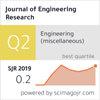Experimental and numerical investigation of rotating bending fatigue of polylactic acid 3D printed parts by an extrusion-based additive manufacturing method
IF 0.9
4区 工程技术
Q3 ENGINEERING, MULTIDISCIPLINARY
引用次数: 0
Abstract
This study investigates the impact of four parameters, namely layer height, nozzle temperature, infill percentage, and bed temperature, on the fatigue life of polylactic acid (PLA) printed parts using the extrusion-based additive manufacturing (AM) process. The experiments were designed using the Taguchi method, considering three levels for each parameter. The extent of the impact and the optimal values of the process variables were determined by using analysis of variance (ANOVA) and signal-to-noise ratio. To predict the fatigue behavior, an empirical model was presented, which was fitted to the fatigue results of the samples made with the optimal process variable values using the least squares method. Additionally, finite element simulations were conducted, and the results were compared with the experimental study findings. The results indicated that the optimal process variable values for maximum fatigue strength are a layer height of 0.3 mm, a nozzle temperature of 220 , a 100 % infill and a bed temperature of 60 . The ANOVA results revealed that the infill percentage, nozzle temperature, and layer height have the greatest influence on fatigue life, with respective contributions of 60.5 %, 28.1 %, and 7.7 %. The experimental modeling and finite element simulation results indicate that the proposed models predict fatigue behavior with regression coefficients of 96.3 % and 98.7 %, respectively.
基于挤压的增材制造方法对聚乳酸 3D 打印部件旋转弯曲疲劳的实验和数值研究
本研究采用基于挤压的增材制造(AM)工艺,研究了层高、喷嘴温度、填充百分比和床层温度这四个参数对聚乳酸(PLA)打印部件疲劳寿命的影响。实验采用田口方法进行设计,每个参数考虑三个水平。通过方差分析(ANOVA)和信噪比确定了工艺变量的影响程度和最佳值。为了预测疲劳行为,提出了一个经验模型,该模型使用最小二乘法拟合了使用最佳工艺变量值制作的样品的疲劳结果。此外,还进行了有限元模拟,并将结果与实验研究结果进行了比较。结果表明,获得最大疲劳强度的最佳工艺变量值为层高 0.3 毫米、喷嘴温度 220 ℃、填充率 100 % 和床层温度 60 ℃。方差分析结果表明,填充率、喷嘴温度和层高对疲劳寿命的影响最大,分别占 60.5%、28.1% 和 7.7%。实验建模和有限元模拟结果表明,所提出的模型对疲劳行为的预测回归系数分别为 96.3 % 和 98.7 %。
本文章由计算机程序翻译,如有差异,请以英文原文为准。
求助全文
约1分钟内获得全文
求助全文
来源期刊

Journal of Engineering Research
ENGINEERING, MULTIDISCIPLINARY-
CiteScore
1.60
自引率
10.00%
发文量
181
审稿时长
20 weeks
期刊介绍:
Journal of Engineering Research (JER) is a international, peer reviewed journal which publishes full length original research papers, reviews, case studies related to all areas of Engineering such as: Civil, Mechanical, Industrial, Electrical, Computer, Chemical, Petroleum, Aerospace, Architectural, Biomedical, Coastal, Environmental, Marine & Ocean, Metallurgical & Materials, software, Surveying, Systems and Manufacturing Engineering. In particular, JER focuses on innovative approaches and methods that contribute to solving the environmental and manufacturing problems, which exist primarily in the Arabian Gulf region and the Middle East countries. Kuwait University used to publish the Journal "Kuwait Journal of Science and Engineering" (ISSN: 1024-8684), which included Science and Engineering articles since 1974. In 2011 the decision was taken to split KJSE into two independent Journals - "Journal of Engineering Research "(JER) and "Kuwait Journal of Science" (KJS).
 求助内容:
求助内容: 应助结果提醒方式:
应助结果提醒方式:


